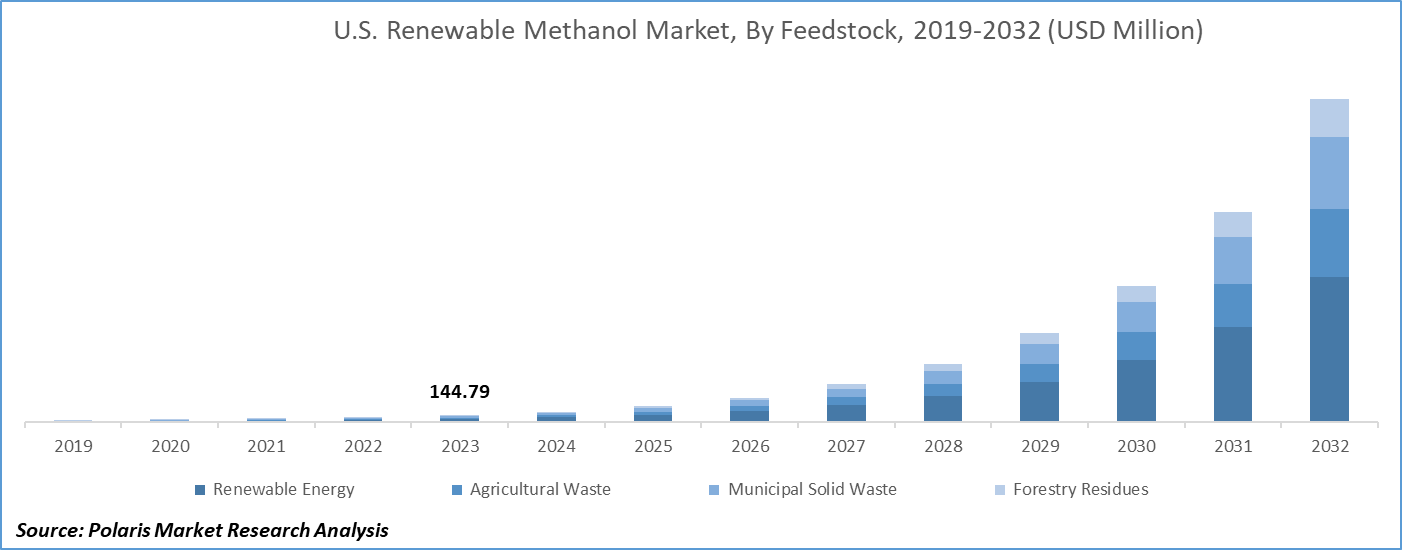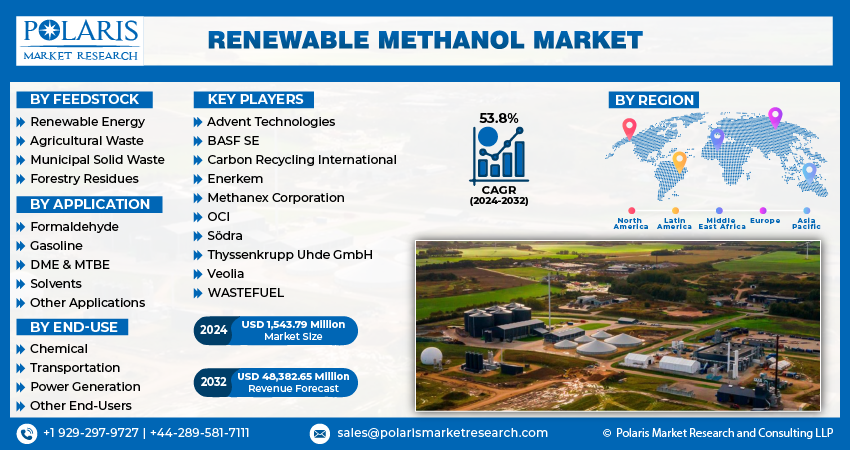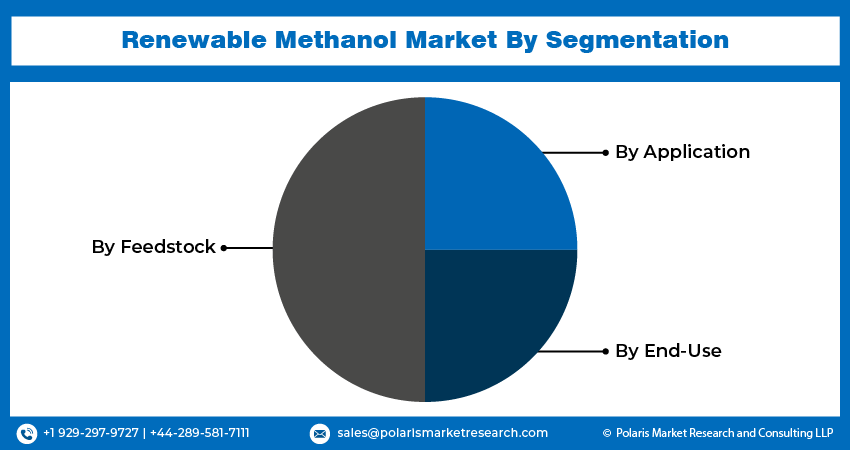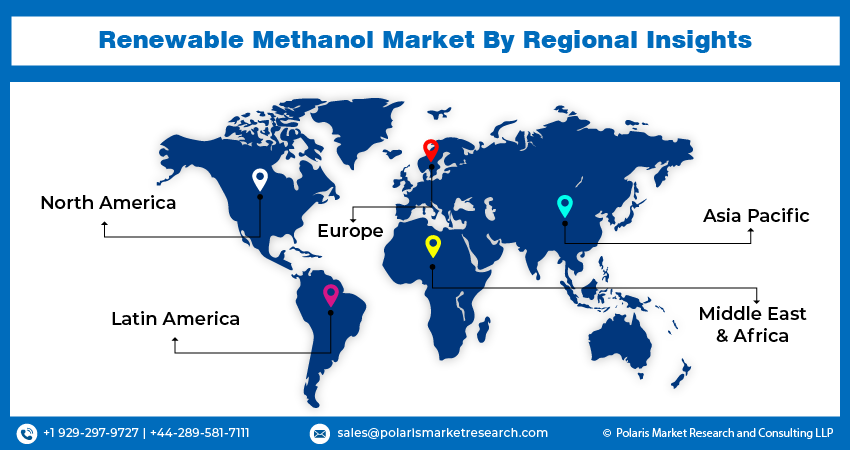
Renewable Methanol Market Share, Size, Trends & Industry Analysis Report
By Feedstock (Renewable Energy, Agricultural Waste, Municipal Solid Waste, Forestry Residues); By Application; By End-Use Industry; By Region; Segment Forecast, 2025 - 2034
- Published Date:Jun-2025
- Pages: 145
- Format: PDF
- Report ID: PM3277
- Base Year: 2024
- Historical Data: 2020-2023
The global Renewable Methanol Market was valued at USD 1,622.8 million million in 2024 and is forecasted to grow at a CAGR of 25.20% from 2025 to 2034. Sustainable chemical feedstock and alternative fuel applications are driving market expansion.
Industry Trends
Renewable methanol, derived from sustainable feedstocks such as biomass, municipal waste, or captured carbon dioxide, is gaining traction as an environmentally friendly alternative to traditional methanol production methods, which rely heavily on fossil fuels. Its utilization in chemical compounds like formaldehyde and mineral turpentine oil (MTO) has been on the rise due to its potential to mitigate climate change and reduce greenhouse gas emissions.

To Understand More About this Research:Request a Free Sample Report
The chemical industry's growing use of renewable methanol in formaldehyde and MTO is closely tied to sustainability practices. Formaldehyde and MTO are essential chemical compounds widely used in various industries, including agrochemicals, paints and coatings, food, cosmetics, and pharmaceuticals. For instance, in October 2023, Sulzer and ANDRITZ collaborated to support Veolia's biomethanol plant in Finland, utilizing innovative technology to produce high-quality biomethanol from pulp mill waste. By incorporating renewable methanol into their production processes, companies can reduce their carbon footprint and meet regulatory requirements for emission reductions.
Reducing greenhouse gas emissions is a critical factor driving the growth of the renewable methanol market. Traditional methanol production processes emit significant amounts of greenhouse gases, contributing to climate change. By transitioning to renewable methanol, industries can substantially lower their emissions, thereby mitigating environmental impact and aligning with global sustainability goals.
Key Takeaways
- Europe dominated the market and contributed over 45% market share of the renewable methanol market size in 2023
- By feedstock category, the renewable energy segment dominated the global renewable methanol market size in 2024
- By application category, the gasoline segment is projected to grow with a significant CAGR over the renewable methanol market forecast period
What are the market drivers driving the demand for market?
Growing focus on reducing carbon emissions
The growing global focus on reducing carbon emissions is driving the demand for renewable methanol in several ways. With countries committing to significant cuts in their carbon emissions and striving for net-zero targets, there is a pressing need for sustainable alternatives to traditional fossil fuels. Renewable methanol offers a promising solution as it can be produced from renewable sources such as biomass, carbon capture, and hydrogen derived from renewable electricity. As major emitters like the G20 countries aim to increase their ambition and action in reducing emissions, the renewable methanol market stands to benefit from the heightened demand for cleaner energy sources.
Simultaneously, increasing investment in building energy efficiency has played a crucial role in reducing CO2 emissions and has indirectly influenced the growth of the renewable methanol market. For instance, in 2021, investments in building energy efficiency rose by 16% to USD 237 billion, yet CO2 emissions increased by 5%, surpassing pre-pandemic levels, signaling a rebound in energy consumption. Investments in energy-efficient buildings help decrease overall energy consumption and subsequently reduce carbon emissions associated with heating, cooling, and electricity usage.
Several countries have made significant pledges towards carbon neutrality, further driving the momentum for renewable methanol adoption. For instance, the European Union, Japan, the Republic of Korea, and over 110 other nations have committed to achieving carbon neutrality by 2050, with China aiming to achieve it before 2060. These pledges underscore the global commitment to reducing carbon emissions and transitioning towards cleaner energy sources like renewable methanol to achieve climate targets. In conclusion, as the world intensifies its efforts to combat climate change by reducing carbon emissions and transitioning towards carbon neutrality, the demand for renewable methanol is expected to soar.
Which factor is restraining the demand for the market?
Lack of infrastructure for the production of renewable methanol hinders the market growth
The renewable methanol market faces significant challenges primarily due to the need for more infrastructure for its production. The infrastructure required for producing renewable methanol, such as specialized manufacturing facilities and distribution networks, still needs to be developed compared to traditional methanol production. This deficiency inhibits the scalability and widespread adoption of renewable methanol as an alternative fuel source. Inadequate infrastructure hinders efficient market growth.
Moreover, the high installation cost of manufacturing facilities presents another obstacle to market expansion. Establishing production plants for renewable methanol involves substantial capital investment, including equipment procurement, technology implementation, and facility construction. These costs are often prohibitive for potential investors and manufacturers, limiting the number of facilities that can be built and slowing down market growth. The infrastructure gap and uncertain returns deter many from investing large sums upfront, impeding progress.
Furthermore, the interplay between infrastructure limitations and high installation costs creates a cyclical challenge for the renewable methanol market. Insufficient infrastructure not only restricts production capacity but also drives up costs by necessitating specialized solutions for production and distribution. Conversely, the high cost of establishing manufacturing facilities discourages investment in infrastructure development, perpetuating the cycle of underinvestment. Strategic interventions such as incentivizing infrastructure development and reducing barriers to entry for manufacturers can help the renewable methanol market overcome challenges and realize its full potential as a sustainable energy solution.

Report Segmentation
The market is primarily segmented based on feedstock, application, end-use, and region.
|
By Feedstock |
By Application |
By End-Use |
By Region |
|
|
|
|
To Understand the Scope of this Report:Speak to Analyst
Category Wise Insights
By Feedstock Insights
Based on feedstock category analysis, the market has been segmented on the basis of renewable energy, agricultural waste, municipal solid waste, and forestry residues. In 2023, the renewable energy has emerged as the dominant segment in the global market because it has gained immense popularity in the past few decades owing to rising concerns about the depletion of fossil fuels and rising global temperature generated due to greenhouse gas (GHG) emissions. Moreover, the growing rate of industrial installations coupled with an increased rate of commercial activities such as transportation and the release of harmful gases such as carbon dioxide and carbon monoxide from the combustion of traditional fuels are promoting the renewable methanol market growth. Accordingly, in order to reduce the growing dependency on hydrocarbon-based fuels such as natural gas, crude oil, and coal, among others, industries are promoting the need for alternative fuels such as renewable methanol.
Additionally, based on the factors above, renewable methanol has emerged as an alternative fuel to diesel, gasoline, and coal, among others tends to boost the market growth. In addition, the rising trends, including the requirement for energy-efficient engines that emit fewer pollutants and reduced emissions of GHGs such as nitrogen oxide, sulfur oxide, and carbon dioxide, are driving the demand for renewable methanol. Moreover, the perception of renewable energy is mainly attributed to the production of renewable methanol by means of a process that combines CO2 and one of the renewable resources, such as hydrogen, generated by the electrolysis process.
By Application Insights
Based on application category analysis, the market has been segmented on the basis of formaldehyde, gasoline, dimethyl ether (DME) & methyl tert-butyl ether (MTBE), solvents, and other applications. The gasoline segment is projected to witness a progressive growth rate in the forecasting years. Gasoline, being the traditional fuel, is utilized by most of the traditional internal combustion engines (ICEs) globally. However, gasoline-based ICEs are among the major contributors to pollution that results in the emission of GHGs. For instance, according to the US Environmental Protection Agency report, a gallon of gasoline emits nearly 8,887 grams of CO2, which contributes to the rise in the level of GHG emissions. Accordingly, governments across the countries have started the application of dual-fuel engines in vehicles, which will emit less pollution, thus resulting in the minimization of pollutants.
In addition, key factors attributed to the demand for renewable methanol as a blending fuel in gasoline is to reduce the level of pollutants being emitted by various sectors, including commercial, private, and industrial. Moreover, renewable methanol blend with gasoline is being promoted due to its key applications such as octane booster, transition fuel, and fuel extender, among others.

Regional Insights
Europe
Europe accounted for the largest revenue share in the global market. Renewable methanol in the region encompasses various aspects related to its production, consumption, and market dynamics. Europe represents a significant market for renewable methanol, driven by increasing demand for low-carbon fuels and chemicals. The market is expected to grow as renewable energy technologies mature, production costs decline, and awareness of environmental sustainability increases.
Europe is actively engaged in international collaboration initiatives aimed at advancing renewable energy technologies, including renewable methanol. Collaborative projects, partnerships, and knowledge exchange with countries outside Europe contribute to the development and deployment of renewable methanol technologies.
Asia Pacific
The Asia Pacific market is anticipated to exhibit the highest CAGR over the forecasting years. Countries in the Asia-Pacific region, particularly those experiencing rapid industrialization and urbanization, are increasingly concerned about air quality and greenhouse gas emissions. As a result, there is a growing emphasis on renewable energy sources and cleaner fuels like renewable methanol to mitigate environmental impacts. Renewable methanol has a wide range of industrial applications, including as a fuel for transportation, a feedstock for chemical production, and a renewable energy carrier. As industries in the APAC region seek cleaner and more sustainable alternatives to traditional fuels and feedstocks, the demand for renewable methanol is expected to increase.
Advances in technology for producing renewable methanol more efficiently and cost-effectively are driving market growth. Research and development efforts focused on improving production processes, enhancing catalysts, and increasing the yield of renewable methanol from biomass or carbon dioxide capture are expanding the market potential in the APAC region.

Competitive Landscape
The renewable methanol market is comprised of key players such as Advent Technologies, BASF SE, ThyssenKrupp Uhde GmbH, Veolia, and Södra. These companies have a large customer base and strong distribution networks, giving them a competitive edge in terms of market reach and penetration. The market is highly competitive, with players vying for market share through continuous advancements in production technology, strategic collaborations, and a strong focus on innovation.
Some of the major players operating in the global market include:
- Advent Technologies
- BASF SE
- Carbon Recycling International
- Enerkem
- Methanex Corporation
- OCI
- Södra
- Thyssenkrupp Uhde GmbH
- Veolia
- WASTEFUEL
Recent Developments
- In March 2025, KAPSOM supported the launch of the world’s first industrial-scale e-methanol project in Denmark, supplying key systems and advancing green fuel technology to aid global carbon reduction and energy transition.
- In September 2023, Advent Technologies revealed its latest line of Serene Power Systems, which are designed to incorporate a compact battery along with a small fuel cell configuration. The fuel cell can be operated with methanol or eMethanol, which makes this system much more efficient for various technical applications.
- In September 2023, OCI Global announced its intention to increase its production capacity to around 400,000 metric tons per year. This move is in response to the increasing demand for green methanol from various high-emission industries such as road transport, shipping, and industrial sectors.
- In April 2022, Veolia, in close cooperation with Metsä Fibre, launched the biorefinery project worldwide in Finland, which aims to produce CO2-neutral bio-methanol from a pulp mill. This project will help to explore the untapped potential of using alternative sources of feedstock for biofuel.
Report Coverage
The renewable methanol market report emphasizes on key regions across the globe to provide better understanding of the product to the users. Also, the report provides market insights into recent developments, trends and analyzes the technologies that are gaining traction around the globe. Furthermore, the report covers in-depth qualitative analysis pertaining to various paradigm shifts associated with the transformation of these solutions.
The report provides detailed analysis of the market while focusing on various key aspects such as competitive analysis, feedstock, application, end-use, and their futuristic growth opportunities.
Renewable Methanol Market Report Scope
|
Report Attributes |
Details |
|
Market size value in 2025 |
USD 1,319.00 million |
|
Revenue forecast in 2034 |
USD 9,827.30 million |
|
CAGR |
25.20% from 2025 – 2034 |
|
Base year |
2024 |
|
Historical data |
2020 – 2023 |
|
Forecast period |
2025 – 2034 |
|
Quantitative units |
Revenue in USD million and CAGR from 2025 to 2034 |
|
Segments covered |
By Feedstock, By Application, By End-Use, By Region |
|
Regional scope |
North America, Europe, Asia Pacific, Latin America; Middle East & Africa |
|
Customization |
Report customization as per your requirements with respect to countries, region and segmentation. |
FAQ's
The global renewable methanol market size is expected to reach USD 9,827.30 Million by 2034
Key players in the renewable methanol market are Advent Technologies, BASF SE, Thyssenkrupp Uhde GmbH, Veolia, Södra, WASTEFUEL
Asia-Pacific contribute notably towards the global renewable methanol market.
The global renewable methanol market exhibiting the CAGR of 25.20% during the forecast period.
The renewable methanol market report covering key segments are feedstock, application, end-use, and region.
